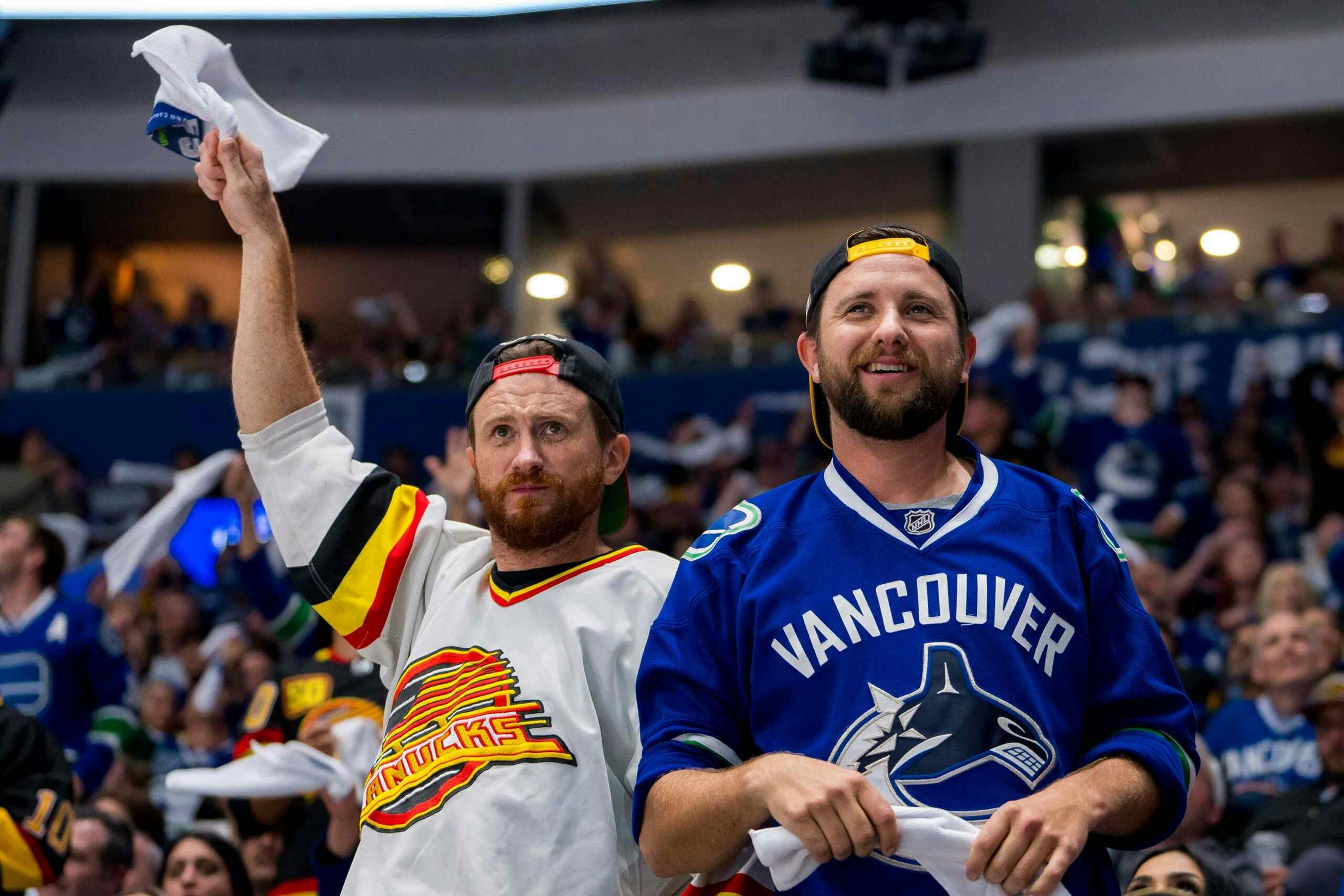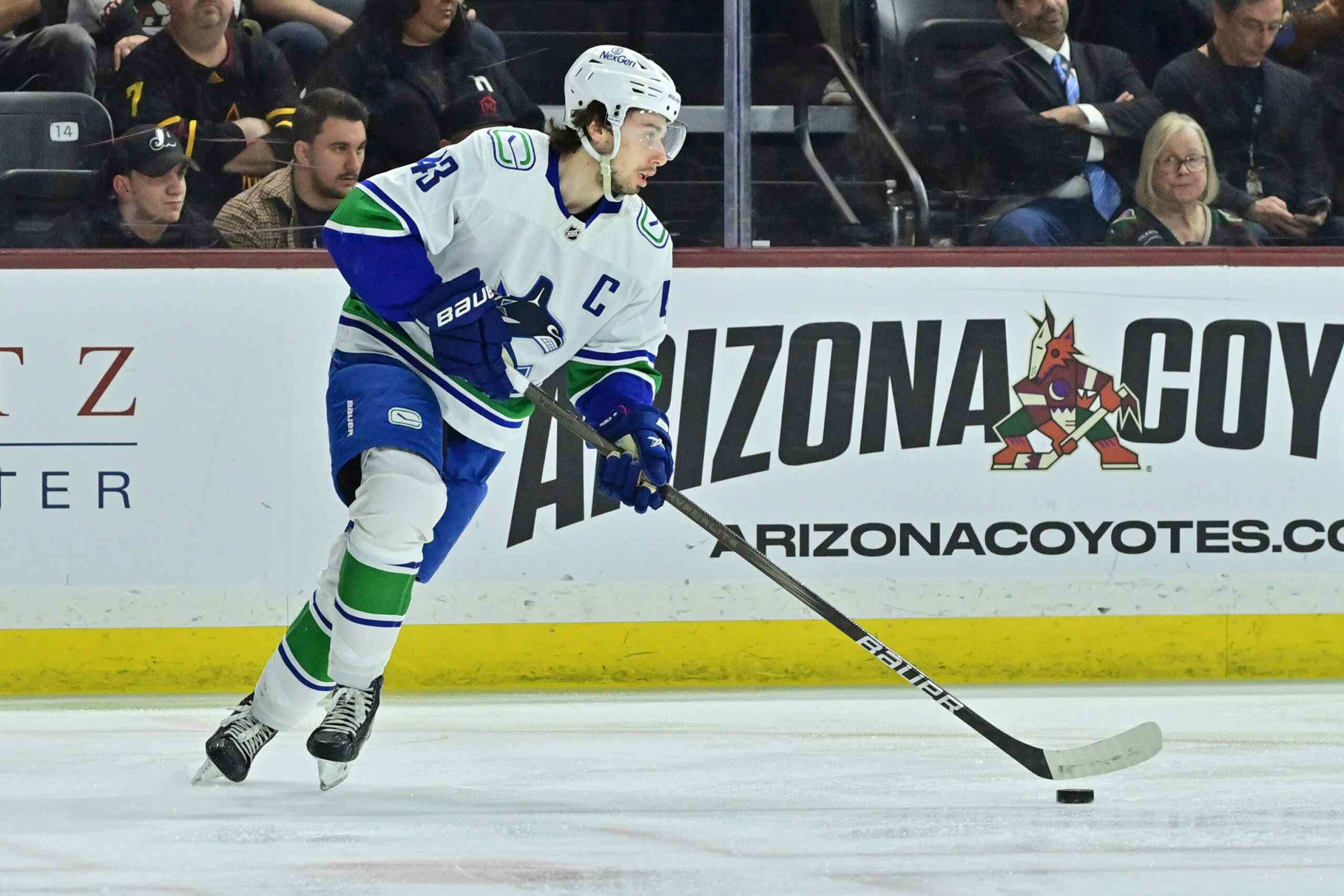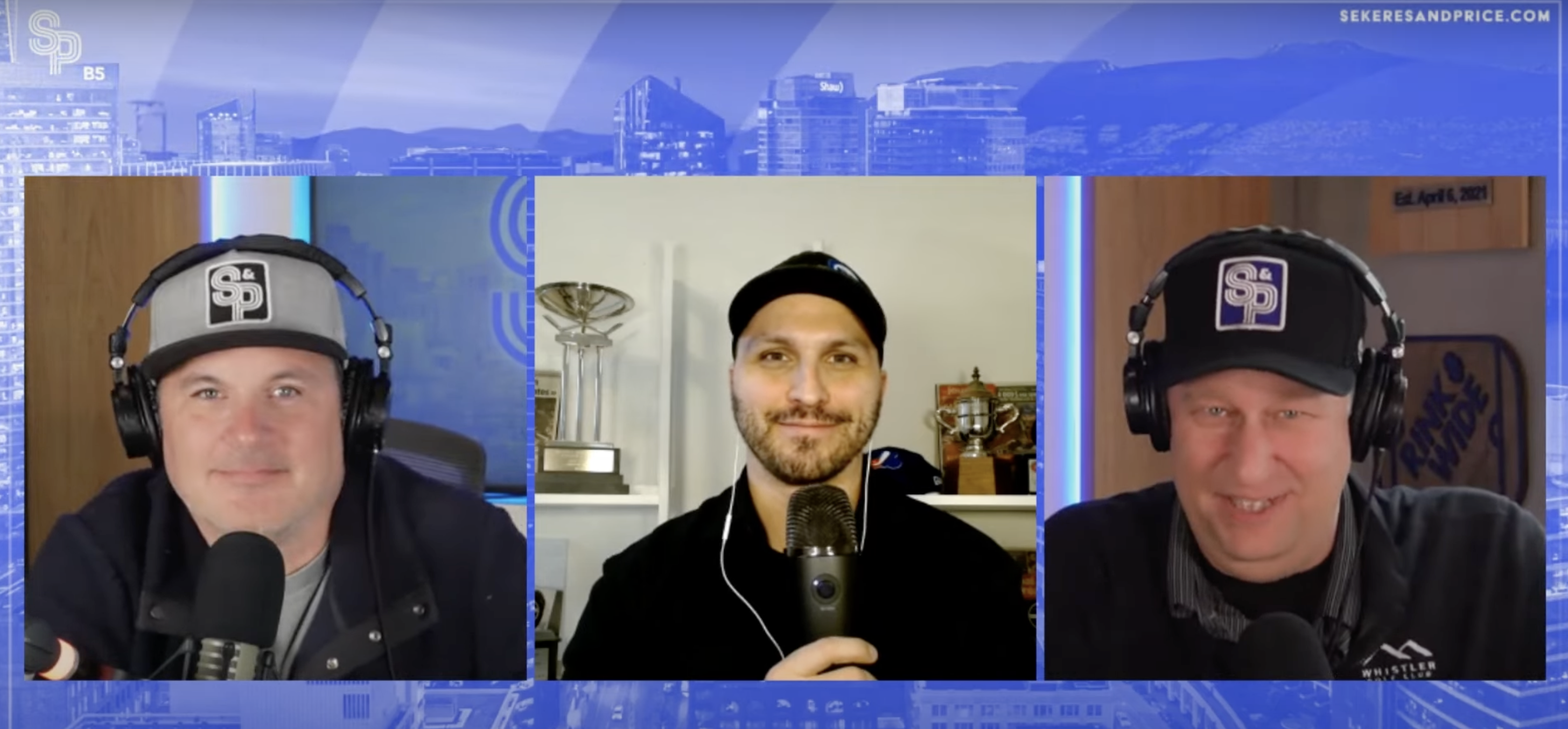The Vancouver Canucks need to prioritize signing Josh Leivo over Jake Virtanen
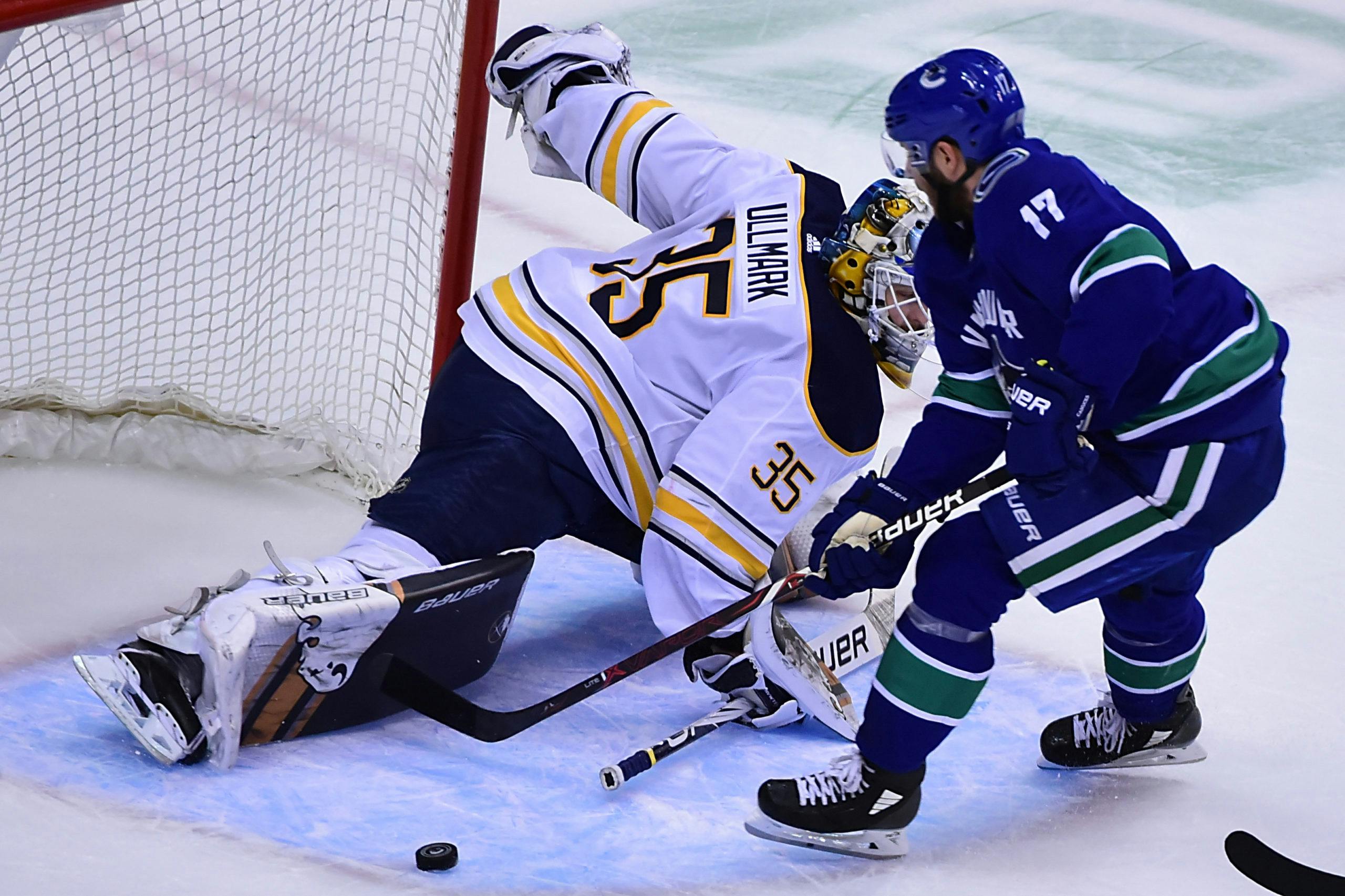
By Bill Huan
3 years agoThe Canucks should prioritize re-signing Josh Leivo over Jake Virtanen this offseason.
There, I said it. I’m now going to log out of Twitter for the next couple hours to spare myself from the war that I’ve started between analytics nerds and people who still believe that Virtanen will become the next Todd Bertuzzi.
In all seriousness, there are a few reasons why Vancouver should make re-signing Leivo a higher priority than Virtanen. First of all, Leivo provides the Canucks with a lot more versatility than Virtanen does while also being more reliable defensively.
More importantly, Virtanen has enough trade value to help the team get rid of Loui Eriksson’s contract and allow Vancouver to re-sign most, if not all of their pending free agents. This is undoubtedly at the top of Jim Benning’s to-do list and using Virtanen as a trade chip can help him accomplish just that.
Before we dive deeper into those factors, however, we need to first take a look at Leivo’s injury and what to expect from him once he hits the ice.
Let’s get started.
Leivo’s Injury
In order to see how Leivo might recover from his fractured kneecap, we need to find some players who have suffered similar injuries. Over the past few years, Trevor Van Riemsdyk and Kevan Miller are the only players that I found who have also dealt with broken/fractured kneecaps, and their recovery process couldn’t have been more different.
Van Riemsdyk had surgery to repair a broken kneecap in late 2014 but managed to recover in time to suit up during the 2015 finals and win a championship with Chicago. He was able to get back on the ice after less than four months of rehab and has since enjoyed a relatively injury-free career.
On the other hand, Miller has undergone four separate procedures for a fractured knee cap that he suffered in April 2019 and has yet to play since. This certainly makes Leivo’s situation more dire since he was originally slated to miss only 2-3 months but has yet to hit the ice.
Fortunately, I still believe that there’s reason for optimism to assume that Leivo will make a full recovery.
Firstly, Leivo’s injury doesn’t seem as serious as Van Riemsdyk’s since he suffered a fractured kneecap instead of a full break, and the latter was able to make a full recovery anyways.
In regards to Miller, Leivo is four years younger and his playstyle is nowhere near as physical, which means that his body doesn’t have as much mileage and should recover much better. More importantly, Leivo hasn’t been required to undergo any procedure like Miller so any potential setback he might’ve suffered doesn’t seem as serious.
Moreover, Leivo has never been the fastest skater, so it’s not like the injury will be putting the greatest asset of his game at risk. He relies on his hockey IQ to make plays, and that isn’t going to change with this injury. There hasn’t been much information given to the public in regards to his recovery process and I’m not a doctor, but I do have faith that he will be able to make a full recovery when taking these factors into consideration.
Leivo vs Virtanen
Although Virtanen is younger and plays a flashier game, Leivo produces at a similar offensive rate while being a more versatile player due to his defensive prowess. The latter can also play on both wings, which allows the Canucks to deploy him up and down their lineup without much issue.
At the time of his injury, Leivo was tied with J.T. Miller for fourth on the team in five on five points, but Virtanen was surprisingly second with 17 points in the team’s first 36 games, which was only behind Elias Pettersson. However, Virtanen’s play was unsustainable since he had an IPP (individual point percentage) of over 90% while Leivo’s was just under 56%.

Most five on five points at the time of Leivo’s injury
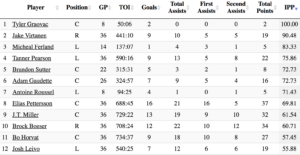
IPP at all strengths at the time of Leivo’s injury
If you’re not familiar with IPP, it’s a stat that shows the number of times that a player registers a point for every goal scored by his team when he was on the ice. To put this in perspective, most forwards have IPPs around the 70% range, which indicates that Virtanen’s production was about to regress while Leivo’s probably would have increased.
Like many predicted, Virtanen’s numbers dropped off a cliff as he only managed nine more five on five points in the last 33 games of the season. Furthermore, he still finished the year with an IPP of over 83% and a shooting percentage (12%) that’s almost 3% higher than his career average, which suggests that his struggles might’ve lasted even longer had the season not been suspended. There’s a real possibility that Virtanen might’ve missed out on scoring 20 goals or 40 points if play wasn’t shut down, considering he only had five points in the final 18 Canucks games before the pause.
In other words, the numbers suggest that Leivo’s production would’ve increased had he not been injured while Virtanen’s might’ve continued to regress if the season wasn’t suspended. The fact that they ended the year with nearly identical points per game averages considering their opposing circumstances suggests that Leivo is at the very least a comparable, if not better, offensive player than Virtanen.
On defence, it isn’t even close.
Using Micah Blake McCurdy’s graphs on HockeyViz, we can see that the Canucks have given up 2.74 expected goals per hour when Leivo has been on the ice at five on five this season. This mark is seven percent worse than the league average but still better than the team’s average, which shows Vancouver’s defensive shortcomings this year.
Meanwhile, the Canucks gave up 2.87 expected goals per hour when Virtanen was on the ice in the same situations, which is 12% worse than the league average and also worse than the team’s average. The difference between him and Leivo might not seem too large, but context is needed in order to paint a clearer picture.
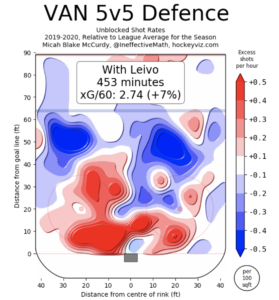

This season, Leivo spent 33.5% of his ice time against elite competition, which is the fourth most among forwards on the team, only behind Vancouver’s second line of Horvat, Eriksson and Pearson. This isn’t a coincidence since Leivo spent a large amount of his time on Horvat’s left-wing before his injury and Eriksson replaced him afterwards.
In comparison, Virtanen only spent 26.5% of his ice time against elite competition and was still one of the worst defensive forwards on the team.
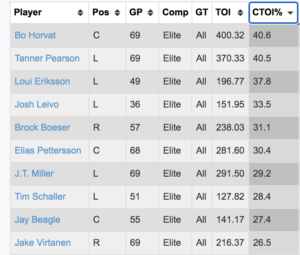
If you’re looking for more of an apples to apple comparison, we can use Leivo’s 2018-19 deployment instead. Last year, he spent less than 30% of his ice time against the elite and faced average competition 39% of the time, which is only two percent higher than Virtanen did this season.
The results were phenomenal, as Vancouver only gave up 2.44 expected goals per hour at five on five, which was one of the best numbers on the team and was six percent better than the league average.
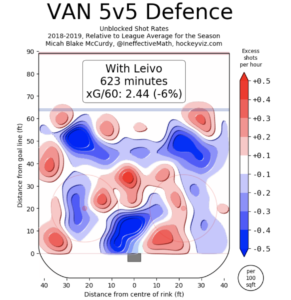
This shows that Leivo is able to tread water defensively against elite competition but feasts against players similar to his calibre, while Virtanen is a liability no matter who he plays against.
Unsurprisingly, Leivo is a much better play-driver than Virtanen as well; since the start of last season, he has controlled shot attempts at five on five over 53% of the time and has an expected goals share of over 51%. Virtanen, meanwhile, has controlled shot attempts only 48.31% of the time and has an abysmal expected goals share of 44.88%.
After looking at these numbers, it’s obvious that Leivo is a much better defensive player while being just as potent offensively as Virtanen, if not more. His strong possession numbers shows that he can adequately drive play by himself and is also capable of being a good complimentary piece when playing with better linemates.
Furthermore, Leivo will be cheaper to re-sign due to his injury and has proven to be a better overall player than Virtanen, so the Canucks can kill two birds with one stone if they do retain him this offseason. Virtanen also has more trade value given his age and could help Vancouver free up a substantial amount of cap room, which is what we’ll discuss in the following section.
Packaging Virtanen with Eriksson
Last summer’s Patrick Marleau trade showed the league that the asking price to get rid of a bloated contract is sky-high. The Leafs needed to attach a first-round pick to get off of his remaining contract that was worth $6.25 million against the cap with only a year left on the deal.
Unfortunately, Eriksson has two seasons left on his contract and has performed much worse than Marleau did on the Leafs. The latter still flirted with 40 points the season before his trade while Eriksson’s offensive game has completely abandoned him.
This suggests that getting rid of Eriksson might cost even more than a first-round pick, but we need to keep in mind that the Leafs had little leverage due to their unprecedented situation with their RFAs. The Canucks are cap-strapped as well but their situation isn’t as dire as Toronto’s was since Vancouver might only lose a supporting player such as Toffoli or Tanev after they re-sign Markstrom; the Canucks aren’t in danger of losing a franchise cornerstone like Pettersson, which was what Toronto was facing with Marner. The bulk of Eriksson’s salary has been paid as well, so he could be more palatable to a team that is looking to cut costs, especially in the wake of COVID-19.
With that said, it seems fair to assume that opposing teams will need to be enticed with something close in value to a first-round pick for them to take on Eriksson’s deal, similar to what the Leafs had to do with Marleau.
The next step would be to figure out what the Canucks need to attach alongside Eriksson for a team to bite, and Virtanen seems to be the most logical fit. He arguably has the most trade value outside of Hughes, Markstrom and the teams top six and could demand around $3 million on his next deal.
Vancouver would be able to replace him with Leivo, who’s a better player and can be signed for less due to his injury, and the team will also have more cap space to spend on its other free agents if they trade Virtanen.
The closest comparable to Virtanen’s trade value would be Andre Burakovsky, who was dealt from the Capitals to the Avalanche last summer in exchange for a second and third-round pick and Scott Kosmachuk, who was a throw-in.
I don’t think Virtanen is worth as much as Burakovsky was since the latter had outproduced Virtanen for most of his career leading up to his trade. Burakovsky also did this on a much deeper team and doesn’t have the off-ice issues that Virtanen has been criticized for.
However, I don’t think Virtanen’s value is too far off of Burakovsky’s last summer since the former Capital did struggle mightily during his final season before the trade. If Burakovsky fetched a second and third-round pick, Virtanen is probably worth a second plus a later pick, such as a fifth-rounder.
Since Virtanen isn’t quite as valuable as a first-round pick, the Canucks will need to add an additional piece in order to trade Eriksson. The most realistic proposal would be something along the lines of Virtanen, Eriksson and another mid-round pick to a team with lots of cap space for a sixth or seventh-round pick in return.
It’s certainly a hefty price to pay, but Vancouver will free up $6 million in the process while also having one less player to sign re-sign. More importantly, by trading Virtanen alongside Eriksson, the Canucks will only need to get rid of another small contract like Jordie Benn’s to have the cap space to re-sign all their free agents.
I chose Benn’s contract since the team has a number of young defensemen knocking on the door and getting rid of the veteran won’t cost as much as trading away some of the team’s other bloated deals. Given that he has one year left on his deal and only costs $2 million against the cap, dealing Benn will probably cost a late-round pick swap at most.
If the team can trade away Virtanen, Eriksson and Benn, they will now have about $25 million to re-sign all of their pending free agents. This should be enough to bring back the whole band; I’ve included some rough estimates as to how much each player could be signed for this offseason:
Jacob Markstrom: $5.5-5.75 million.
Tyler Toffoli: $5.25 million.
Chris Tanev: $4.5-4.75 million.
Troy Stecher: $2.25-2.5 million.
Adam Gaudette: $2-2.25 million.
Josh Leivo: $1.5-1.75 million.
Tyler Motte: $1 million.
Zack MacEwen: $1 million.
These deals add up to about $24 million in total, which still leaves a million left in cap space to re-sign Oscar Fantenburg if the Canucks don’t feel like some of their young defensemen such as Olli Juolevi and Jack Rathbone are ready to be the left defenseman on the third pairing yet.
In Summary…
There’s reason to be optimistic that Leivo will be able to make a full recovery given his playstyle and severity of the injury. When healthy, he’s also a more impactful player than Virtanen given his two-way presence and play-driving ability and can be signed for less.
Meanwhile, Virtanen can be packaged with Eriksson to free up cap space which will allow the team to re-sign all of their pending free agents. The Canucks will be able to ice an even more potent forward group next season with Toffoli back and Leivo taking Virtanen’s right-wing position on the third line. The former Leaf is capable of playing on both wings and will provide Adam Gaudette with some defensive stability while also producing at a 30-40 point pace over a full season.
All in all, it seems wise for the Canucks to prioritize re-signing Leivo over Virtanen; after years of perseverance, his hard work might finally pay off if he remains in Vancouver.
Recent articles from Bill Huan
- From Pettersson’s wing to the low minute man: How should the Canucks utilize Andrei Kuzmenko moving forward?
- We watched every one of Bo Horvat’s goals since 2021 to break down his evolution into an elite goal-scorer with the Canucks
- Four Canucks storylines that everyone should be thankful for this Christmas


